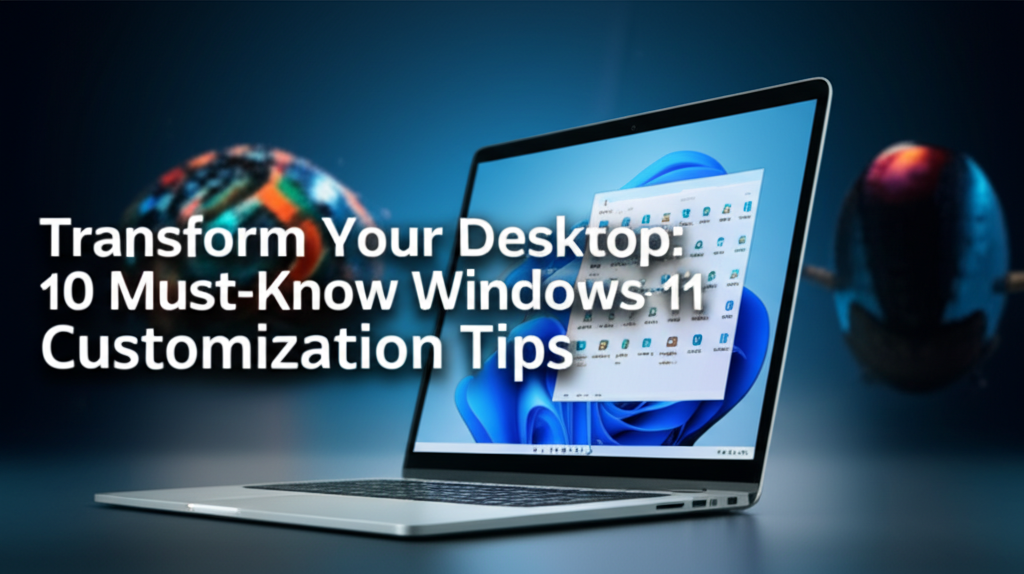Windows 11 brings a fresh aesthetic and features designed to enhance productivity and user satisfaction. For many users, the desktop is the first thing they interact with when they boot up their computer. Customizing it to suit your needs can streamline your workflow, improve productivity, and even make your computing experience more enjoyable. In this article, we will explore ten essential customization tips for your Windows 11 desktop that even beginners can follow.
Why Customization Matters
A well-organized and personalized desktop can significantly impact your efficiency when using your computer. Customizing your desktop helps you:
- Access frequently used applications and files quickly: By organizing your desktop, you’ll reduce the time spent searching for applications and files.
- Enhance your productivity: Tailoring your environment to fit your workflow helps keep distractions at bay.
- Express your personality: Personalizing your desktop gives it a unique touch that reflects who you are.
Let’s dive into our top ten Windows 11 customization tips!
Tip 1: Set the Perfect Wallpaper
Why It Matters
The wallpaper is the backdrop of your desktop. A visually appealing wallpaper can create a pleasant environment, fostering focus and enjoyment.
Step-by-Step Instructions
- Right-click on the Desktop: Select Personalize from the context menu.
- Choose Background: Click on Background to view different options.
- Select Your Preferred Image:
- You can pick from Windows wallpapers, select a solid color, or click Browse to find an image on your PC.
- Change the Background Style: Choose whether you want the image to fill, fit, stretch, or be displayed in another manner.
Alternative Recommendations
Some websites for stunning wallpapers include:
- Unsplash: High-quality, free photos.
- Pexels: A great source for stunning royalty-free images.
- Wallhaven: A larger collection of wallpapers across various styles.
Common Errors
- Wallpaper not displaying correctly: Ensure that the image resolution matches your display settings. Adjust the background style if necessary.
Tip 2: Customize the Taskbar
Why It Matters
The taskbar is crucial for accessing apps, tools, and notifications. Customizing it enhances accessibility.
Step-by-Step Instructions
- Right-click on the Taskbar: Choose Taskbar settings.
- Adjust Taskbar Behaviors:
- Taskbar Alignment: Select Center or Left.
- Taskbar Items: Toggle items like Search or Task View on/off based on your preference.
- Pin Applications: Open an app, right-click its icon on the taskbar, and select Pin to taskbar.
Common Errors and Fixes
- Taskbar freezing: Restart Windows Explorer by right-clicking the taskbar in Task Manager and selecting Restart.
Tip 3: Arrange Your Desktop Icons
Why It Matters
Organizing your desktop icons ensures you always know where to find your applications or files.
Step-by-Step Instructions
- Right-click on the Desktop: Select View and choose whether you want Large, Medium, or Small icons.
- Arrange Icons: You can drag icons around or right-click, select Sort by, and choose based on name, size, item type, or date modified.
- Create Folders: Group related applications/files by creating folders. Right-click on the desktop, select New, then Folder.
Advanced Tips
- Use Folder Shortcuts: Create shortcuts for frequently accessed folders directly on your desktop.
Tip 4: Enable Virtual Desktops
Why It Matters
Virtual Desktops can help you organize your workspace more efficiently, especially if you juggle multiple projects.
Step-by-Step Instructions
- Open Task View: Click the Task View icon on the taskbar or press Win + Tab.
- Add a New Desktop: Click on New desktop at the top.
- Switch Between Desktops: Use the Task View to select your desired desktop.
Common Errors & Quick Fixes
- Desktops overlapping applications: Ensure to drag applications to the correct desktop in Task View.
Tip 5: Customize Your Widgets
Why It Matters
Widgets provide quick access to important information like weather, news, or calendar events without cluttering your desktop.
Step-by-Step Instructions
- Access Widgets: Click on the Widgets icon in the taskbar.
- Personalize Your Widgets: Click on the profile icon at the top-right corner of the Widgets panel.
- Add or Remove Widgets: Select which widgets you want to display.
Alternative Recommendations
Consider third-party applications like Rainmeter for more customizable widget options.
Tip 6: Change System Sounds
Why It Matters
Changing system sounds can add personality to your machine or make alerts more noticeable.
Step-by-Step Instructions
- Right-click on the Start Menu: Select Settings.
- Select System: Click on Sound and then scroll down to Advanced sound options.
- Change Sounds: Click on App volume and device preferences.
- Customize Sound Scheme: Search for Change system sounds and customize alerts and notifications.
Common Errors
- No sound: Check your sound settings to ensure your device is properly configured.
Tip 7: Tweak File Explorer
Why It Matters
File Explorer is your gateway to navigating files and applications. Customizing it can lead to smoother navigation.
Step-by-Step Instructions
- Open File Explorer: Press Win + E.
- Change the Layout: Select View at the top and choose between Details, List, or Tiles views.
- Pin Frequently Used Folders: Right-click the desired folder, click Pin to Quick Access.
Advanced Tweaks
Use keyboard shortcuts like Ctrl + N for a new window or Alt + Up Arrow to move up a folder.
Tip 8: Utilize Snap Layouts
Why It Matters
Snap layouts can help you multitask by easily organizing open windows.
Step-by-Step Instructions
- Hover on Maximize Button: When you hover over the maximize button of an open window, a layout will appear.
- Select Your Layout: Choose how you want to snap the window.
- Arrange Other Windows: Simply select other windows to fill the spaces.
Common Errors
- Windows not snapping: Ensure that Snap windows is enabled in Settings > System > Multitasking.
Tip 9: Use Accessibility Features
Why It Matters
Windows 11 comes with many accessibility features that enhance usability for all users.
Step-by-Step Instructions
- Open Settings: Select Accessibility from the left menu.
- Explore Features: From text size adjustments to high contrast options, click on features of interest to customize them according to your needs.
Alternative Software Recommendations
Apps like Magnifier and Narrator are built-in tools that can help enhance accessibility.
Tip 10: Final Touches with Themes
Why It Matters
Themes can change the overall look of your desktop, including backgrounds, sound schemes, and cursor styles.
Step-by-Step Instructions
- Right-click on the Desktop: Go to Personalize and select Themes.
- Explore Available Themes: Select a theme or download new ones through the Microsoft Store.
Quick Fixes
- Theme not applying: Ensure your version of Windows 11 is updated.
Summary Checklist for Quick Reference
- Set a catchy wallpaper: Personalize your space.
- Customize the taskbar: Pin essential apps for easy access.
- Organize desktop icons: Use folders for better organization.
- Enable virtual desktops: Separate your work environments.
- Customize widgets: Get quick access to important information.
- Change system sounds: Personalize audio notifications.
- Tweak File Explorer: Improve file navigation efficiency.
- Utilize snap layouts: Easily manage multiple windows.
- Explore accessibility features: Use built-in tools for ease of use.
- Finish with themes: Give your desktop a cohesive aesthetic.
With these ten tips to transform your Windows 11 desktop, you’re well on your way to creating a personalized and efficient working environment. Start customizing today, and enjoy a more productive computing experience!

